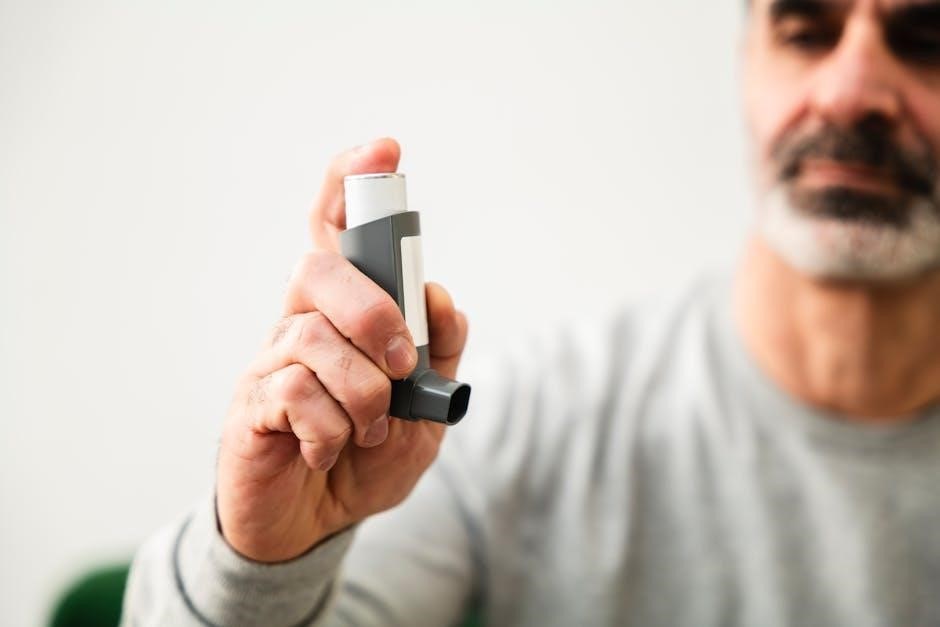Chronic obstructive pulmonary disease (COPD) significantly impacts breathing and daily activities. Exercise plays a crucial role in managing symptoms‚ improving lung function‚ and enhancing overall quality of life.
Understanding COPD and Its Impact on Physical Activity
Chronic obstructive pulmonary disease (COPD) is a progressive lung condition that makes breathing difficult‚ significantly impacting physical activity. It damages the airways and reduces lung function‚ leading to shortness of breath even during simple tasks.
Physical activity becomes challenging due to reduced oxygen intake and increased fatigue. However‚ tailored exercises can help manage symptoms‚ improve lung function‚ and enhance overall well-being. Understanding how COPD affects the body is essential for developing safe and effective exercise routines.
Exercise helps strengthen respiratory and skeletal muscles‚ improving breathing efficiency and endurance. It also boosts stamina‚ enabling individuals with COPD to perform daily activities with greater ease. A well-designed exercise plan can significantly improve quality of life.
Benefits of Exercise for COPD Patients

Benefits of Exercise for COPD Patients
Exercise improves symptoms‚ enhances quality of life‚ and boosts physical function in COPD patients. It strengthens muscles‚ increases stamina‚ and promotes better oxygen utilization‚ making daily tasks easier.
Improving Lung Function and Overall Health
Regular exercise enhances lung function by strengthening respiratory muscles‚ improving oxygen intake‚ and increasing overall circulation. For COPD patients‚ this leads to better breathing and reduced shortness of breath. Physical activity boosts endurance‚ allowing individuals to perform daily tasks with more energy. Over time‚ exercise can improve lung capacity and reduce the frequency of exacerbations. Additionally‚ it promotes better heart health and reduces inflammation‚ contributing to overall well-being. Strengthening the diaphragm and intercostal muscles helps improve breathing efficiency‚ making it easier to manage symptoms. Consistent exercise also enhances mental health by reducing anxiety and depression‚ fostering a more positive outlook on life with COPD.

Types of Exercises Suitable for COPD
Types of exercises for COPD include breathing exercises‚ aerobic activities‚ and strength training‚ each designed to improve lung function‚ endurance‚ and overall muscle strength.
Breathing Exercises for Better Oxygen Intake
Breathing exercises are essential for COPD patients to enhance oxygen intake and manage shortness of breath. Techniques like diaphragmatic breathing and pursed-lip breathing help strengthen respiratory muscles and improve airflow. Diaphragmatic breathing engages the diaphragm‚ increasing lung capacity‚ while pursed-lip breathing slows exhaling‚ keeping airways open longer. These exercises can be done daily and are often recommended in COPD exercise PDF guides. Regular practice improves breathing efficiency‚ reduces fatigue‚ and enhances overall quality of life. They are simple‚ effective‚ and can be incorporated into any exercise routine‚ making them a cornerstone of COPD management.
Aerobic Exercises to Enhance Endurance
Aerobic exercises are vital for improving endurance in COPD patients. Activities like walking‚ swimming‚ and cycling are highly recommended as they strengthen the heart and lungs‚ boosting overall stamina. These exercises enhance the body’s ability to utilize oxygen efficiently‚ reducing breathlessness and fatigue. For COPD patients‚ moderate-intensity aerobic exercises‚ such as 20-30 minutes of brisk walking three to four times a week‚ are often suggested. Consistency is key to improving endurance and managing symptoms effectively. Always consult a healthcare provider before starting any new exercise program to ensure safety and suitability for individual health conditions.
Strength Training for Muscle Development
Strength training is an essential component of a COPD exercise plan‚ focusing on building muscle mass and improving overall physical stability. Simple exercises like weight lifting‚ resistance bands‚ or bodyweight exercises (e.g.‚ squats‚ chair pushes) can help strengthen the muscles used for breathing‚ such as the diaphragm and intercostal muscles. This can enhance respiratory efficiency and reduce fatigue. For COPD patients‚ strength training should be moderate and performed 2-3 times a week‚ with gradual progression to avoid overexertion. Consistent strength training not only improves mobility but also supports better posture and balance‚ making daily activities easier to manage. Always consult a healthcare provider to tailor the routine to individual needs and capabilities.

Creating a COPD Exercise Plan
A well-structured exercise plan for COPD should be personalized‚ focusing on realistic goals and gradual progression. Consult a healthcare provider to ensure safety and effectiveness.
Daily Exercise Routines for COPD Management
Daily exercise routines for COPD management should focus on consistency and gentle progression. Start with short sessions (20-30 minutes) and gradually increase duration. Morning routines may include breathing exercises like diaphragmatic breathing and pursed-lip breathing to improve oxygen intake. Gentle aerobics‚ such as walking or chair exercises‚ can follow. After a short rest‚ incorporate strength training using light weights or resistance bands to build muscle endurance. Always include warm-up and cool-down stretches to prevent strain. Rest periods are essential to avoid overexertion. Tracking progress in an exercise log can help monitor improvements and stay motivated. Consulting a healthcare provider ensures routines are tailored to individual needs and symptoms.
Weekly Exercise Schedules and Goals
A well-structured weekly exercise schedule for COPD management should balance activity and rest. Aim for 3-4 days of moderate aerobic exercises‚ such as brisk walking or swimming‚ lasting 20-30 minutes per session. Incorporate strength training twice a week to build muscle endurance‚ focusing on upper body exercises to improve breathing. Rest days are essential to avoid overexertion and allow recovery. Set realistic weekly goals‚ such as increasing walking distance or duration. Progress should be tracked in an exercise log to monitor improvements. Always consult a healthcare provider to tailor routines to individual needs and ensure safety. Consistency and gradual progression are key to achieving long-term benefits and managing COPD symptoms effectively.
tips for Sticking to Your Exercise Plan
Consistency is key to benefiting from exercise with COPD. Start with small‚ achievable goals and gradually increase intensity. Keep an exercise log to track progress and stay motivated. Schedule workouts at the same time daily to build a routine. Focus on activities you enjoy‚ such as walking or swimming‚ to make exercise more sustainable. Incorporate rest days to avoid overexertion and allow your body to recover; Celebrate milestones‚ no matter how small‚ to maintain motivation. Consider exercising with a partner or group for support. Most importantly‚ listen to your body and adjust your plan as needed to ensure long-term adherence and positive outcomes for COPD management.

Safety Considerations for COPD Exercises
Always consult your doctor before starting a new exercise program. Use oxygen therapy as prescribed and monitor your breathing to avoid overexertion and complications.
Precautions to Take While Exercising
Exercising with COPD requires careful planning to ensure safety and effectiveness. Always consult your healthcare provider before starting a new program to discuss limitations and risks. Use oxygen therapy as prescribed and monitor your breathing patterns to avoid overexertion. Avoid exercising in extreme temperatures or polluted environments‚ as this can worsen symptoms. Stay hydrated to keep airways moist and avoid irritation. Learn to recognize signs of distress‚ such as increased shortness of breath or chest pain‚ and stop immediately if they occur. Carry an emergency inhaler if prescribed and inform someone nearby about your condition; Regular monitoring and gradual progression are key to a safe and beneficial routine.
Understanding Your Limits and Monitoring Progress
Recognizing your physical limitations is crucial when exercising with COPD. Start with short‚ manageable sessions and gradually increase duration and intensity. Use a symptom diary to track improvements in breathing‚ endurance‚ and energy levels. Set realistic goals based on your current fitness level and celebrate small achievements. Regularly monitor oxygen levels using a pulse oximeter if prescribed. Work closely with your healthcare provider to adjust your exercise plan as needed. Understanding your limits ensures a safe and sustainable approach to physical activity‚ helping you avoid setbacks and maintain long-term progress. Consistency and patience are key to achieving lasting benefits for your health and well-being.
Additional Resources for COPD Exercise Programs
Explore pulmonary rehabilitation programs and downloadable COPD exercise PDF guides for structured routines‚ breathing techniques‚ and safe workout plans tailored to your needs and fitness level.
Pulmonary Rehabilitation Programs
Pulmonary rehabilitation programs are tailored for individuals with COPD‚ offering structured exercise routines and breathing techniques to improve lung function and overall health. These programs are typically supervised by healthcare professionals and include a combination of aerobic exercises‚ strength training‚ and flexibility workouts. They are designed to enhance endurance‚ reduce breathlessness‚ and promote a more active lifestyle. Many programs also incorporate educational sessions on managing COPD symptoms and improving daily living. Participating in pulmonary rehabilitation can significantly boost physical and mental well-being‚ helping individuals with COPD lead more fulfilling lives. These programs are often recommended as a safe and effective way to start or maintain an exercise routine‚ especially for those new to physical activity or with severe symptoms.
Downloading COPD Exercise PDF Guides
Downloading COPD exercise PDF guides is an excellent way to access structured workout plans tailored for individuals with chronic obstructive pulmonary disease. These guides often include detailed instructions for breathing exercises‚ aerobic activities‚ and strength training‚ all designed to improve lung function and overall health. Many reputable medical websites‚ hospitals‚ and pulmonary organizations offer free or paid downloadable resources. When searching for COPD exercise PDFs‚ ensure they are created by healthcare professionals and include safety tips and modifications for different fitness levels. These guides can serve as a convenient reference for daily routines‚ helping individuals with COPD stay active and manage symptoms effectively from the comfort of their homes.
